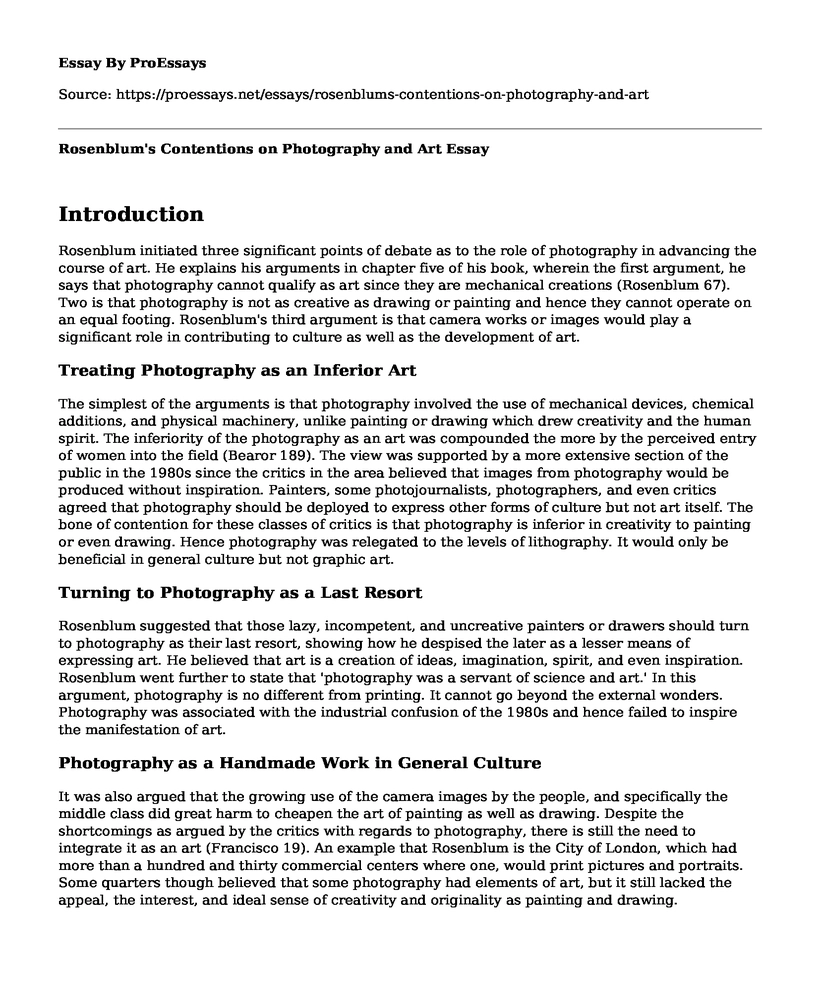Introduction
Rosenblum initiated three significant points of debate as to the role of photography in advancing the course of art. He explains his arguments in chapter five of his book, wherein the first argument, he says that photography cannot qualify as art since they are mechanical creations (Rosenblum 67). Two is that photography is not as creative as drawing or painting and hence they cannot operate on an equal footing. Rosenblum's third argument is that camera works or images would play a significant role in contributing to culture as well as the development of art.
Treating Photography as an Inferior Art
The simplest of the arguments is that photography involved the use of mechanical devices, chemical additions, and physical machinery, unlike painting or drawing which drew creativity and the human spirit. The inferiority of the photography as an art was compounded the more by the perceived entry of women into the field (Bearor 189). The view was supported by a more extensive section of the public in the 1980s since the critics in the area believed that images from photography would be produced without inspiration. Painters, some photojournalists, photographers, and even critics agreed that photography should be deployed to express other forms of culture but not art itself. The bone of contention for these classes of critics is that photography is inferior in creativity to painting or even drawing. Hence photography was relegated to the levels of lithography. It would only be beneficial in general culture but not graphic art.
Turning to Photography as a Last Resort
Rosenblum suggested that those lazy, incompetent, and uncreative painters or drawers should turn to photography as their last resort, showing how he despised the later as a lesser means of expressing art. He believed that art is a creation of ideas, imagination, spirit, and even inspiration. Rosenblum went further to state that 'photography was a servant of science and art.' In this argument, photography is no different from printing. It cannot go beyond the external wonders. Photography was associated with the industrial confusion of the 1980s and hence failed to inspire the manifestation of art.
Photography as a Handmade Work in General Culture
It was also argued that the growing use of the camera images by the people, and specifically the middle class did great harm to cheapen the art of painting as well as drawing. Despite the shortcomings as argued by the critics with regards to photography, there is still the need to integrate it as an art (Francisco 19). An example that Rosenblum is the City of London, which had more than a hundred and thirty commercial centers where one, would print pictures and portraits. Some quarters though believed that some photography had elements of art, but it still lacked the appeal, the interest, and ideal sense of creativity and originality as painting and drawing.
Works Cited
Bearor, Karen A. "NWSA Journal." NWSA Journal, vol. 9, no. 3, 1997, pp. 189-193.
JSTOR, www.jstor.org/stable/4316541.Francisco, Jason. "Teaching Photography as Art." American Art, vol. 21, no. 3, 2007, pp. 19-24. JSTOR, JSTOR, www.jstor.org/stable/10.1086/526477.
Rosenblum, Naomi. A world history of photography. New York: Abbeville Press, 1997.
Cite this page
Rosenblum's Contentions on Photography and Art. (2022, Mar 09). Retrieved from https://proessays.net/essays/rosenblums-contentions-on-photography-and-art
If you are the original author of this essay and no longer wish to have it published on the ProEssays website, please click below to request its removal:
- Becoming a Professional Ballet Dancer
- Essay Example on How Social Media Affect Teens
- Johnny Cash's and Jason Aldean's Writing Styles Paper Example
- Essay Sample on Cultural Influences in "What About Bob" Movie
- Movie Analysis Essay on Spirited Away
- Music: Enhancing Lives and Educations of Students - Essay Sample
- Descriptive Writing: Creating Visual Concepts for Poetry & Fiction - Essay Sample







